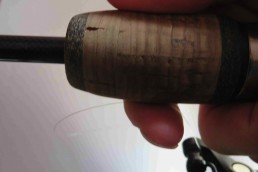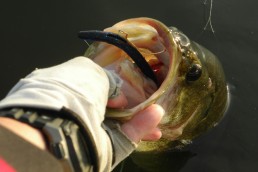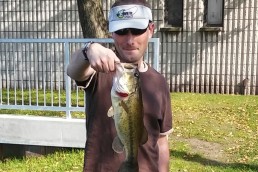California Stitching Applied to the Midwest
SHARE THIS POST
Writing the book on bass
I happened upon a book published in 1992 entitled In Pursuit Of Giant Bass by Californian Bill Murphy, who was a then a living legend. He pioneered a technique called stitching, which slowly works soft plastic bait or live bait by gently pulling in the line by hand, occasionally reeling up the excess.
Murphy claimed stitching 6-inch plastic worms hooked more California lunkers than any other technique. Co-author Paul Prorock added the Midwest, Buck Perry style dedication to structure. Murphy fused the California reservoir approach. For those who have tried finesse techniques I can assure you that we are in the initial stages. My initial stitching inquiries and success have proven this rates high as a finesse tactic.
Why all the fuss about this old, mostly unheard of technique? Because it works. I landed a 20-inch largemouth bass from a highly pressured, clear pond the first time I tried stitching. This is exactly the type of fishing situation in which Murphy claimed stitching would shine. Stitching can catch big, pressured bass that have seen everything.
Much has changed in bass fishing since the book’s publication, but Murphy’s rationale for stitching is as sound as ever.
Stitching bass fishing techniques
The main stitching rig has a small hook, round, non-reusable split shots, and a 6-inch plastic worm. A 4-inch worm could be substituted for inactive bass. You can experiment with your favorite plastic offerings by varying plastic body styles, using different sinker designs, or no weight. Nightcrawlers, crawfish, and minnows can also be used for stitching.
Stitching could work for any species. Nothing I used before works structure more methodically or with such precision. Nothing catches larger sized fish in shifting north-to-east winds and clear water. That kind of wind makes many anglers stay at home. Stitching provides a remedy for largemouth lockjaw and helps you make your best of the most challenging angling situations.
Setting up to stitch
The great news is you probably already have the necessary tackle to begin. All you need is a 7-foot or longer medium-light spinning rod spooled with 6- or 8-pound test on about a 5:4 ratio spinning reel. Outfit this with your favorite plastic worm, and a small finesse hook, like a No. 2 Gamakatsu split shot drop shot hook. For nightcrawler fishing I prefer a No. 8 Tru Turn. Pinch the split shot 18 inches or less from the worm. You want just enough weight so there’s minimal tension on the line. Working the rig drags on the bottom quite a bit. Murphy claimed this created a natural noise pattern in the water, with the potential of drawing in bass that have grown acclimated to other noise.
I affix the sinker more toward the hook with plastic worms. It’s a matter of preference. The main goal of this technique is to have an offering hang around the prime structural areas of deepest drop-offs for ample time.
My rod recommendations are either a graphite 8 ½ light action steelhead or 7 ½ medium light fiberglass or composite rod for improved casting distance with ease. I prefer 6-pound copolymer line; 8-pound around cover or thick vegetation. Copolymer is more abrasion resistant than monofilament, stretches less, and is more sensitive. You don’t want limp monofilament for this application.
Big bass bites
Bass inhale the plastic deep due to there being little weight or resistance. You can let a bass run a few feet away from obstructions before giving a moderate hookset.
The book calls for a skin hooking technique. This rigging catches too much vegetation in our Midwest and Northern waterways. I quickly modified my rig by hooking a 6 in. trick-style plastic worm through the middle, wacky-style. The total rig (worm and split shot) weighs around 1/8 ounce. It weighs more if you add shot for deeper or windier situations.
Are you enjoying this post?
You can be among the first to get the latest info on where to go, what to use and how to use it!
Finger work
After the worm sinks to the bottom, grab the line with reeling hand. Place the line on your forefinger, and maintain a steady tension. In wind, sit down and keep the rod low. When the line from your forefinger goes slack, pick it up with your middle finger. You basically are pulling the line in slowly with your fingers. Reel in when the line in your hand starts to get unmanageable.
When casting in wind or seated higher, as in a bass boat, you’ll need to use the forefinger from the hand holding the rod to provide tension fot the stitching process. You can even experiment stripping an unweighted 5 inch soft stickbait (Senko) like a fly-rod streamer this way. I landed a quality bass last May doing that.
You may want to keep your spinning reel bail open when there’s little wind. A non-infinite anti reverse spinning reel allows for a more fluid stitching retrieval. In the book, Murphy showcased exactly how he worked the worm. The usage of fingers on the line is something new to learn.
Improving the feel of your fishing
You’ll be amazed at how you can feel structure through the line. Work the line with your fingers again, reel in, and repeat. This slow, unencumbered motion gives your worm the most natural, undulating feel possible. You can feel drop-offs, vegetative edges, boulders or wood. No top-of-the-line graphite rod transmits this information as well. When the bass strikes, close you bail, reel in your slack line, and lift into a moderate hookset.
This is indeed a big bass technique. I prefer subdued plastic worm colors of watermelon, scuppernong, and black. Don’t deviate from the small, smooth split shot with light plastics. As it gets nicked it catches the dirt, rock, or wood on the bottom, further tantalizing those wary lunkers into striking.
Hand line fishing has been around forever. The trick to catching big bass consistently with stitching is fine, gradual attention to small detail, patience and a determination to seek fewer strikes while targeting big bas. You must leave the little bass in shallow cover alone.
Accomplishments
In spring 2017 I landed some good sized bluegills while nightcrawler stitching in cool conditions, along with a 19-inch bass. A 20-inch bass fell for a 6-inch Mann’s Jelly Worm stitched from the back of a bass boat. My final “stitched” lunker came in the first week of August on an unweighted 6-inch black Zoom Trick worm.
Having your nerves on a “hair trigger” like traditional wacky worming or Texas rigging is not required. Apply that focus to the technique itself. Once you learn to stitch line, it’s a relaxing way to fish and fairly easy to master. Stitching is fun and productive for lots of species. Developed in California, it is perfectly suited for the Midwest.
Bill Murphy’s “In Pursuit Of Giant Bass” goes into finer detail for explaining big bass, and their structural relationships.
For more information…
For more on stitching and other methods, watch Racz’s YouTube channel.
MWO
SHARE THIS POST
Did you enjoy this post?
You can be among the first to get the latest info on where to go, what to use and how to use it!
Frank Racz
With almost two decades of fishing retail knowledge, Frank Racz’s dedication to the “stitching technique” has led to a modern Midwestern largemouth bass variant and bluegill pursuits. He is avid about the techniques’ multispecies potential and other long spinning rod inquiries featured on his YouTube channel.



